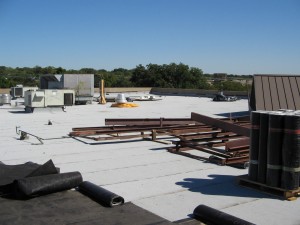Archive for the ‘Green Roofing’ Category
"10 Million Solar Roofs" Bill
Vermont Senator, Bernie Sanders, plus 11 colleagues introduced the act, 10 Million Solar Roofs, arguing that it will create energy independence. The policy will also aid in cutting air and water pollution and reducing greenhouse gas emissions, while creating new green jobs and putting America in the forefront of the global solar power industry.
The aggressive solar policy was approved by Senate Committee on Energy and Natural Resources on Wednesday. Senator Sanders hopes to include his bill in a package that is expected to be before the Senate later this summer.
The 10 Million Solar Roofs bill would fund solar installations through competitive grants. $250 million in grants would be approved in 2012. And between 2013 and 2021, $500 million would be provided annually. Using consumer rebates for purchase and installations of solar systems.
The bill’s ultimate goal is over the next 10 years for 10 million new solar rooftop systems and 200,000 new solar water heating systems to be installed in the United States. The total current US solar energy capacity will be tripled when the bill is fully integrated. If it becomes a law, than going solar will be even more cost efficient for Americans and a step forward towards a clean energy future.
A Simple Yet Effective Way of Stabilizing the Climate
A recent study by a National Center for Atmospheric Research scientist has found evidence to suggest that to stabilize the climatic differences between city center temperatures compared to rural, is to paint buildings roofs white.
This simple yet very effective practice can help reduce the city’s temperature by 1 degree Fahrenheit. For every degree, this helps keep the climate for that city and indeed surrounding area at a more even kilter.
Keith Oleson, the lead scientist and author of the study said, “In theory, our research has shown an effective method of slowing urban heat”. This urban heat is exacerbated by the solid concrete blocks, roads and buildings, which absorb heat, making the ambient temperature rise and thus having a detrimental affect on the climate.
By painting roofs white, as is very popular in Europe particularly Spain and Greece, you allow the sun’s infrared light to pass through the roof insulation. By having white roofs, the urban heat island effect, as it is know, could be reduced by a 1/3 having a positive effect of reducing city’s temperatures. The trial is being tested in cities such as Washington D.C and Seattle, where during the summer months, the temperatures can rise to much higher levels than that of their rural neighbors.
US Energy Secretary Steven Chu is said to be backing the idea and wants the idea rolled out in more major cities throughout the USA. As the rate of greenhouse gases being expelled is still rising, this simple amendment can negate some of the intensity of the damaging affects.
By painting roofs white, this would reduce the world’s cities temperatures by around 0.7 degree Fahrenheit (or 0.4 degrees Celcius) which would bring the pronounced heat of city life down during the summer months especially. In a bid to do everything and anything to slow the rising temperature of the world’s temperature, painting you roof white seems to be one of the easiest.
Cool Roofs Cut Emissions and Cool Climate
Rooftops and roads lighter in color can help reduce carbon dioxide emissions and slow climate change says scientists at Lawrence Berkeley National Laboratories in California. Significantly cutting emissions and combating global climate change by cooling cities and the world, researchers say. ScienceDaily.com reported that cool roofs and cool pavements in cities around the world could cancel the heating effects of up to 2 years of worldwide carbon dioxide emissions.
Cool roofs are one of the quickest and lowest cost ways we can reduce our global carbon footprint. Increasing the reflectivity of roof and pavement materials in cities with population greater than 1 million would achieve a one time offset of co2 emissions double the worldwide co2 emissions levels in 2006. Cool roofs have worked for thousands of years in Mediterranean and Middle Eastern cities where demand for air conditioning is low.
Cool roofs deliver high solar reflectance, reducing the heat transfer to the building. Enhancing roof durability and reducing building cooling needs and the urban heat island effect. The surface of a black roof can increase roof temperatures as much as 90 degrees Fahrenheit. Cool roofs have a typical heat increases of 10-25 degrees Fahrenheit above ambient temperature during the day. There are three types of cool roofs:
- Inherently cool roofs; made of thermoplastic white vinyl, white reflective membranes.
- Coated roofs; ceramic coatings or high performance nanotechnology heat reflective paints.
- Green roofs; typically consisting of an insulation layer, waterproof
membrane, drainage layer, growing medium and plants.
Black roofs are preferable in cooler climates, where more energy is produced to heat the house than to cool it. Green roofs are a good option for cooler climates with a flat roof.
Green Roof Construction Time-lapse
Great Time-lapse of a Green Roof being Constructed. Make sure to check out the video description for more details.
Via (YouTube)
Historic Building Gets Solar Panels
In Philadelphia, the Bourse building built in 1895, received 210 solar panels. Estimated first year savings of $8,000, the system is expected to pay for itself within 5 years.
The 30,000 square foot roof supports the panels by a racking system and ballasts so there is no penetration on the historic roof. The panels avoided the skylights and shadows cast by neighboring buildings, while also not being visible by street level.
In the early 1980’s the Bourse building was converted to a 10 story complex with 75+ tenants of offices, shops and food outlets, supporting nearly 1 million visitors per year.
Read more at philly.com (Philadelphia Enquirer)
2 Billion for Solar Plants

Saturday on his weekly radio program, President Barack Obama announced that the government will be giving close to 2 Billion dollars for new solar power plants.
The president hopes to increase the use of renewable energy and create thousands of jobs in America.
The plan is to bring new industry to the United States and compete aggressively to make sure we secure the jobs and industries of the future.
The two solar companies that will share the money is Abengoa Solar, building a new plant in Arizona and Abound Solar Manufacturing who will be building two plants, one each in Colorado and Indiana, together, the companies will create more than 2000 construction jobs and 1500 permanent jobs.
Read more at news.yahoo.com
Solar Power at the Vatican
The Holy City has installed 2,000 photovoltaic solar panels to the top of one of the city/state’s buildings. In doing so, the Vatican will reduce CO2 emissions by 225 tons a year and save 80 tons of oil.
The solar panels are not visible from the ground, but the angels in St. Peter’s Basilica may have to wear sunglasses to fight off the glare from the panels.
The solar energy system covers the massive roof of the “Nervi Hall”, where Pope Benedict XVI holds general audiences. The 2,400 panels, designed by a Germany company, will heat, light and cool the hall and several surrounding buildings, producing 300 kilowatt hours (MWh) of clean energy a year. The hall, built in 1971 and one of the Vatican’s newest buildings, has a sweeping, wave-shaped roof which made the project feasible. (via telegraph)
Moss can be the Wrong kind of Green Roof
Moss, which thrives in moist, shady areas, can lead to leaks and serious roof damage, writes Brian Rader. To help prevent these problems, homeowners should trim back trees and other vegetation that touches or shades areas where moss growth is a concern. Plant debris and branches also should be cleared from the roof because they can contribute to shade and moisture. Metal roofs work best for moss prevention, he notes.

source: SanJuanIslander.com (Friday Harbor, Wash.)
Austin mulls $10,000 Investment for Vegetated Roof Study
Austin, Texas, might invest $10,000 to study the benefits of vegetated rooftops. The research could be done through an agreement between the University of Texas and the Lady Bird Johnson Wildflower Center.
“As the city becomes larger and more dense and more intensive, are there ways that we can maintain our quality of life and have a lot of the environmental and social and cultural benefits that you would otherwise lose if we pave over these areas?” asked Matt Hollon of Austin Watershed Protection. If the research shows positive effects, more green roofs could be added.
source: News 8 Austin (Texas)
Companies Jump on Rooftop Gardening Bandwagon
A number of companies nationwide are developing technology and techniques to meet the growing demand for rooftop gardening.
- Trenton Forging in Michigan is trying to come up with an energy-efficient way to warm a year-round greenhouse on its roof.
- Sky Vegetables wants to build hydroponic farms on roofs in major metropolitan cities.
- GreenGrid Roofs in Chicago sells a modular system of plastic bins that makes installing rooftop beds easier.
source: Google/The Associated Press












